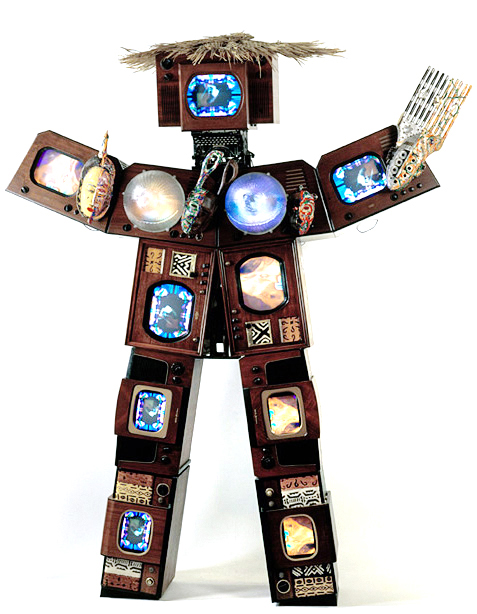Nam June Paik
 Sunday, April 22, 2007 at 1:30AM
Sunday, April 22, 2007 at 1:30AM 
Nam June Paik has long been recognized as a master and pioneer of video and electronic/technology based art. He was also a close associate of composer, John Cage, whom he was known to collaborate with. I’d seen one piece of his in the James Cohan Gallery collection on a prior visit, and have always had an appreciation for his work. The literature provided by the gallery describes Paik’s work as critiquing “culture consumed by technology.” In this way, Paik’s work is very self referential. His technology is not just a critique of, but also an example of “culture consumed by technology.” Often working with the housing cabinets from mid-century TV sets, in the case of all but one of the pieces in this exhibit, with their picture tubes removed and contemporary TVs set into their cabinets. Paik built sculptures- houses, figures, totems, walls, and environments from these cabinets and screens. Later he created work using only contemporary TVs. Television screens were the staple of his work. Of the pieces in this show, his humanoid primitive sculpture, Karen Blixen Robot (shown above), caught my interest most. Though I enjoyed the show, and had built up much anticipation in attending, there was something off that I could not at first put my finger on. Perhaps I went in with my expectations too high. But I think perhaps a combination of factors worked against the exhibit for me. For one, the idea of a wall of TV sets is so reminiscent of any consumer electronic store’s TV department, that nothing about the presentation is particularly riveting, losing some of the impact the approach may have had during the time of some of his earlier work. Although the picture tubes in the TVs had been removed, and “modern” TV sets had been placed within the vintage cabinets, these so-called “new” picture tube TVs have themselves become obsolete, in these days of HD flat-panels. Pioneering as it was in its day, I think Paik’s work suffers the fate of a lot of technology based conceptual art: As technology moves forward, if the work’s impact, no matter how conceptual, is most dependent on presentation rather than interaction, the work itself becomes “dated”. Some of Paik’s work qualifies as immersive, but in this exhibit W3 would be the only example, and by my estimation, the least inspired piece of the show. Tower is certainly monolithic. Perhaps it is the curse of being recently old. Once Paik’s body of work is as old as the mid-century cabinets he used, the perspective will be different and the timeliness issue will not be as it is now. I am glad to have had the opportunity to attend, and I appreciate the James Cohan Gallery for supporting such art.


Reader Comments